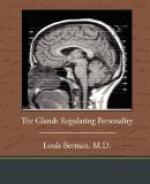Varieties of the human race exist as do varieties of dogs. The pekingese and the fox terrier are as different as the Slav and Latin are different: because of differences in internal secretion make-up. The Slav peasant is definitely subthyroid in his general effect: round head, coarse features, stubby hands, and his stolid, brooding intellectual and emotional reaction. The Latin shows a pronounced adrenal streak in his coloration, his emotivity, his susceptibility to neurosis and psychosis. H. Laing Gordon, a Scot physician, reported that of 700 cases he studied, more than twice as many of duplex eyed individuals (brown or black, i.e., adrenal-centered most often), were susceptible to the mental disturbances of war as the simplex (blue or gray-eyed, i.e., thyroid-centered most often). He also pointed out that such individuals tend to have a narrow and abnormally arched palate. The Anglo-Saxon tends to be more sharply pituitarized, his features are more clean-cut, his mentality more stable. The Frenchman is rather a cross between the Anglo-Saxon pituitary-centered and the Italian or Spanish adrenal-centered.
So national resemblances, traceable to climatic influences being repeated from generation to generation upon the endocrines, may be explained physiologically. The physiologic interpretation of history will indeed be found the broadest, including as complementary Buckle’s climatic theory, Hegel’s ideas on the influence of ideas, and Marx’s on the superiority of the economic motives and forces.
THE RACES OF MANKIND
Arthur Keith, conservator of the Museum of the Royal College of Surgeons of England, was the first to apply the principle of endocrine differentiation to the problem of the color-lines—the lines which have divided mankind crudely into the yellow, the red, the white and the brown, the Negro, the Mongol, the Caucasian, the copper tinted American. It has long been recognized by anthropologists that the differences of color march with differences in every comparable trait. Thus the ideal Negro is built upon a pattern in which all the elements are specific and singular. When the looms revolve that make him, there is produced a gleaming black skin, kinky black hair, squat wide-nostriled nose, thick protruding lips, large striking teeth, prominent jaws, and staring eyes. As his upright carriage and bone-muscle-fat proportions are distinctive, so are his musical voice and his easily wrought upon nerves. In contrast the Caucasian has a good deal of hair on his body, his skin is a pale tan-pink, his lips are thin, and his nose especially has the definite bridge which narrows it. The Mongol, like the Negro, has the hairless body and the beardless face, but unlike him has lank straight hair on his head, while his features are flattened and fore-shortened.




